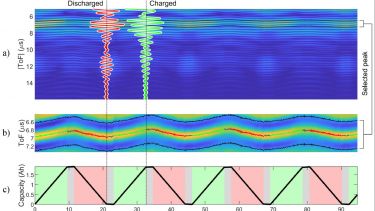There is nothing more annoying than when your phone tells you it has 20% charge left and then suddenly stops running. Detecting the state of charge, SoC in a battery is tricky. It is often done by monitoring it during charging and discharging, so-called column counting. Royce Copley, a PhD student in the Leonardo centre, working on project funded by the EPSRC and Ricardo, has been exploring a new way to do this using ultrasound. He has demonstrated how ultrasound travels through a battery reflecting and transmitting through the anode and cathode layers. As the battery is charged the graphite electrodes absorb lithium and that changes the ultrasonic wave reflection changes slightly (as shown in the picture). Our recent paper explains how to monitor that very small change and correlate it with the state of charge.
Using Ultrasound with a Lithium Ion Battery to Determine Capacity

